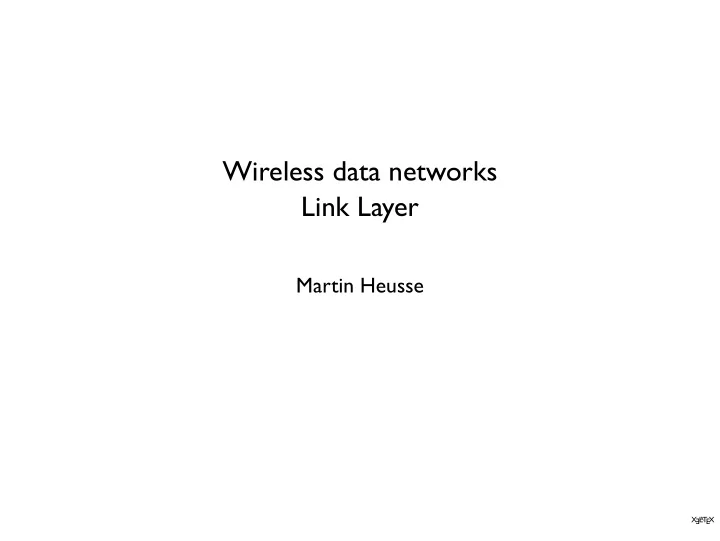

Wireless data networks Link Layer Martin Heusse X L A TEX E
Aloha (1972) i = 1 while (i <= maxAttempts) do send packet wait for acknowledgement or timeout if ack received then Central DATA host leave ACK wait for random time increment i end do Link layer — 2
Aloha performance with Poisson traffic 1 m T exp(-2 m T) 0.8 0.6 P 0.4 0.2 0 0 0.5 1 1.5 2 m T Link layer — 3
Slotted Aloha • Access takes place on discrete time “slots” (D, 2D, 3D ms after the end of the previous transmission) • Number of transmission during a slot: P [ N ( D ) = n ] = ( µ D ) n exp ( − µ D ) n ! • The probability of transmission without collision becomes simply: P [ N ( D ) = 1] = µ D exp ( − µ D ) Max for µ D = 1 • Used for initial access in GSM… Link layer — 4
CSMA for Wireless 802.11 DCF—basic 3 … Data + ACK Data + ACK 2 … Data exponential backoff collision CW ← 2 x CW 1 … Data Host # time DIFS Elapsed backoff Medium busy Residual backoff Link layer — 5
CSMA/CA (Bharghavan 94: MACAW) • Collision Avoidance with hidden terminal • Send a short frame which may collide (RTS) • The intended receiver reserves the channel around himself (CTS with explicit Data frame duration) However, this does not work if a station (D) could not decode the CTS… Data RTS Data A Collision CTS Collision B Data NAV C RTS D Link layer — 6
xIFS: Interframe spacing • SIFS • PIFS • DIFS • EIFS Link layer — 7
802.11 network DS AP BSS STA IBSS Link layer — 8
Structure of a 802.11 frame (+ ACK) t tr Data C 4 bytes MAC header R 30 bytes IP LLC C t cont t pr t pr t ack 50 µs 10 µs ACK MPDU 14 bytes DIFS backoff PLCP PLCP SIFS PLCP PLCP preamble header preamble header Link layer — 9
802.11 Data frame (QoS control field is generally not present) • 4 address fields! (what’s a DS—distribution system?) ✓ Address 1: always used for reception decision ✓ Address 2: Address of transmitting station ✓ Address 3: Final recipient (to DS); Original source (from DS); BSSID (IBSS mode) ✓ Address 4: source address if frame is in transit between relays • Duration: used by other stations to set their NAV Link layer — 10
Address fields content !"#$% &'"(#$% )**'+,,#- )**'+,,#. )**'+,,#/ )**'+,,#0 D D R6&S&$6 H6&S&76 477T$ OP6 D L R6&S&$6 H6&S&477T$ 76 OP6 L D R6&S&477T$ H6&S&76 $6 OP6 L L R6 H6 $6 76 Link layer — 11
ACK frame format RA: address of sender of data frame Link layer — 12
RTS frame format • Duration: RTS+SIFS+CTS+SIFS+DATA+SIFS+ACK Link layer — 13
Management frames • Beacons: ✓ Timestamp ✓ Beacon interval ✓ Capability (PCF available? Encryption required?) ✓ SSID (up to 32 bytes) ✓ Required rates • Association requests/responses Link layer — 14
PLCP Phy. Layer Convergence Proto. • Duration: 802.11b: 192µs @ 1Mb/s (Short preamble option: 72 bits preamble @ 1Mb/s, PLCP head. @ 2Mb/s → 92µs) • Signal: data transmission bit rate Link layer — 15
PLCP OFDM (11a, 11g) 5>?5,J(4;(' KLEG K(-('M(; 54'$1N E4$: CGKOP?G E4$: >GHIEJ 54;,U$1- 5C67 ],A$1- ),A$1 ),A$1 R,A$1- )R,A$1- R,A$1- )Y,A$1- ?/;(;X<#6= ?/;(;X<#6= ,QU5CVB,',W,)XYT ,QKLEG,$-,$8;$941(;,$8,CPIHL>T CPIHL> 5>?5,5'(43A:( 6LEL )Y,CN3A/:- <8(,<#6=,CN3A/: O4'$4A:(,H&3A(',/2,<#6=,CN3A/:- Duration: ≈ 22µs Link layer — 16
802.11a PHYs 3./&/!)*$+! 3./&/!)*$+! "#$#!)*$+! "#$#!%#$&! 3./*24!%#$& 6&%! 6&%!<="(! 6&%!<="(! (./01#$*.2 '()*$+,+- '5- +0)7#%%*&% +>?).1 +>?).1 '8 9:;3 - '8 39:; - '8 "9:; - A! B>CD EFG E H6 GH "! B>CD IFH E H6 IA EG! J>CD EFG G "A H6 E6! J>CD IFH G "A 5G GH! EAKJL= EFG H E"G "A IA! EAKJL= IFH H E"G EHH H6! AHKJL= GFI A G66 E"G MH! AHKJL= IFH A G66 GEA Link layer — 17
One problem in a multirate cell (“Performance anomaly”) • All stations access the network with same probability • So in time T, they will all send approx. the same number of frames • If one of them transmit at 1Mb/s, everybody gets only a fraction of this Link layer — 18
Recommend
More recommend